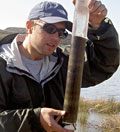Why Paleoclimate?
PROVIDENCE, RHODE ISLAND– Here’s an example of something that inspires me to try to reconstruct past climate.
 2 comments
2 comments PROVIDENCE, RHODE ISLAND– Here’s an example of something that inspires me to try to reconstruct past climate.

 Billy D'Andrea studies the natural variability of Earth’s climate system using single-cell algae as an indicator of past temperatures. He is a NOAA Postdoctoral Fellow working at the University of Massachusetts Amherst, and develops and applies molecular and isotopic techniques to reconstruct past climate change from lake sediments. Billy loves the Arctic and worked in southwest Greenland for seven years prior to beginning research in northwest Norway this summer.
Billy D'Andrea studies the natural variability of Earth’s climate system using single-cell algae as an indicator of past temperatures. He is a NOAA Postdoctoral Fellow working at the University of Massachusetts Amherst, and develops and applies molecular and isotopic techniques to reconstruct past climate change from lake sediments. Billy loves the Arctic and worked in southwest Greenland for seven years prior to beginning research in northwest Norway this summer.













































 Unless otherwise noted, this work is licensed under a Creative Commons Attribution-Noncommercial-Share Alike 3.0 United States License.
Unless otherwise noted, this work is licensed under a Creative Commons Attribution-Noncommercial-Share Alike 3.0 United States License. 
Very exciting science indeed, soon to be Dr. D’Andrea! This Polar Scientist blog concept is fascinating and very informative. Btw—has the Antarctic matched the Artic in sea ice decline? Is one melting faster/refreezing less often than the other? If so–what are the ramifications?
Hi Aaron,
Arctic and Antarctic sea ice are very different because of the geography of the two poles. In the Arctic we have an ocean surrounded by landmasses, while in the Antarctic there is a continent (Antarctica) surrounded by the Southern Ocean. This means that sea ice (frozen sea water) around Antarctica can easily drift north into warmer waters during the Antarctic summer and melt. Arctic sea ice can’t drift south so easily, being blocked by landmasses. This leads to a major difference in the behavior of Arctic and Antarctic sea ice – historically, about 50% of the Arctic winter sea ice survived the summer melt period, while only about 17% of Antarctic winter sea ice survived the summer. They are very different places.
To answer your question, the Antarctic summer sea ice cover has not been rapidly decreasing like the Arctic sea ice. Also, the Antarctic continent has not been warming dramatically like the Arctic has (large areas of Antarctica have been getting cooler, actually). This has to do with differences in the way the atmosphere circulates around the two poles (again because of geographical differences). This is a great example of how changes in climate are regional, not global. Even though climates of different regions are all connected, they do not all shift in the same direction when given a shove.